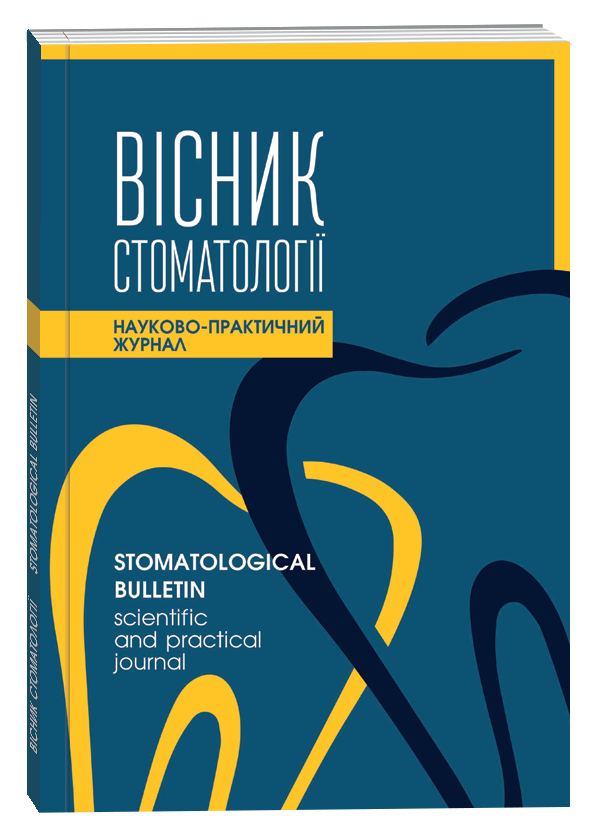TREATMENT OF GİNGİVİTİS İN CHİLDREN WİTH TYPE 1 DM: ANTİBİOTİC OR OZONE
DOI:
https://doi.org/10.35220/2078-8916-2019-34-4-39-44Keywords:
Periodontal disease, Gingivitis, Diabetes Mellitus type 1 in children, Ozonotherapy, Oral healthAbstract
Aim. To compare effects of Ozonoficated olive oil and Metrogyl Denta specimens on microbes in type 1 Diabe-tes Mellitus children with periodontal diseases.
Methods. Diabetic patients were added to group who were registered to No:6 Baku city Hospital Department of Endocrinology between 2013-2017. Also from other cities and regions, total number of 79 patient were selected and orally inspected who had Type I DM. Total 79 Patient ( 46 female, 33 male) , with an average age 12,3±3,4 ( 2-17 age) and 5,1±3,6 years (1-12 years) of disease ( Diabetes Mellitus type 1) duration were participated. After exami-nation and evaluation of children according to specified indexes, in 63 patients was found gingivitis, while the rest 16 patient’s had no pathology in their periodontal tissues.
Patients (63) were divided into 2 groups. First group in-volved patients who were treated with Ozonoficated olive oil (31 Patient) while second group received with “Metrogyl Denta Gel” (32 Patient).
Results. While comparing type 1 DM patients’ gum pock-ets both periodontal tissues with gingivitis and tissues without any inflammation process, we witnessed that they have same microflora. We can see that only microbial colonies have big difference. Therefore, bacteria colonies are greater (2-3 times more) in gum pockets of Diabetic Children with catarrhal gingivitis than in gum pockets of Diabetic Children with healthy periodontium. Incidence of S. Oralis colony in catarrhal gingivitis is 44,65±1,6 %, while it is 24,8±7,2% in noninfected periodontium tissues. Same results are met with S. Sanguis colonies: catarrhal gingivitis has 82,5±4,8 %, while it is 36,1±13,9 % in noninfected periodontium tissues. At the end of treatment procedure (7th day), new microbiologic samples from gum pockets of patients were sent to laboratory. Before treat-ment, aerobic bacterial content in Ozonotherapy group Type 1 DM Patients periodontal pockets was 2094,7±632,9 KOE/ml and in Metrogyl Denta group this number was 2106±702 KOE/ml. These numbers showed insignificant difference of microbial contents in periodon-tal pockets between group patients.
After treatment it was found that, in Ozonotherapy group bacterial colony indicator was 241,7±78,4 KOE/ml and in Metrogyl Denta group 267,4±45,7 KOE/ml. The research showed us that in both groups microflora colonies in per-iodontal pockets had been seriously decreased. In Ozonotherapy group bacterias were decreased by 88,5%, thus in the Metrogyl Denta group the result seem same by decreasing 83,6 %. In treatment of Type 1 DM children with catarrhal gingivitis in their periodontal tissues with Ozonoficated olive oil, we came by significant details. Thus, S. Auerus colonies decreased from 26,6±7,7 % to 10,5±2,2 %. S.Haemolyticus colonies showed 74,7±5,3 % before Ozonotherapy, after therapy 33,8±7,2%, S.Mutans colonies decreased from 35,5±6,3 % to 14,8±8,5 % after therapy with ozonoficated olive oil. Also we see that S.Mitis colonies before therapy showed 45,6±3,7 % but after it had been 18,81±3,3 %, as well as S.Salivarius colony percentage fell from 40,5±7,5 % to 21,05±7,1 % after therapy. Before the therapy we found that S.Epidermidis 42,5±11,4 %, S.Oralis 44,65±1,6 % and S.Mitior 27,3±1,6 % showed some colonies, but after therapy we couldn’t see any of these microorganisms. So, we after treatment of Type 1 DM children with catarrhal gingivitis in their periodontal tissue we found that aerobic microorganisms in gum pockets decreased by 50-70 % whereas S.Epidermidis, S.Oralis, S.Mitior colonies were totally cleaned.
In treatment of periodontal tissue of Type 1 DM children with catarrhal gingivitis with Metrogyl Denta we witness some details . S.Haemolyticus colonies before treatment with Metrogyl Denta were 74,7±5,3%, after treatment it had been 35,8±9,3% , S.Mutans colonies decreased from 35,5±6,3% to 14,9±10,6 %. S.Salivarius colonies de-creased from 40,5±7,5 % to 23,6±13,7 % after therapy.
So, aerobic microorganisms in gum pockets of periodon-tal tissues of Type 1 DM children with gingivitis de-creased by 50-70% with both Ozonoficated olive oil and Metrogyl Denta. Bacteria characteristics in gum pockets of patients were majorly changed by Ozonotherapy. Some bacterias such as, S.Auerus, S.Mitis, S.Oralis, S.Mitior were not seen after thearpy.
Conclusion. Results in treatment of gingivitis in Type 1 Diabetes Mellitus children with periodontal disease with Metrogyl Denta and Ozonoficated olive oil are close to each other. Considering that in compare to Metrogyl Denta olive oil has no side effects, it is more appropriate to be used in the treatment of these type of patients.
References
Mealey BL, Rose LF. Diabetes mellitus and inflam-matory periodontal diseases. Current Opinion in Endocrinology, Diabetes and Obesity. 2008;2(15):135-141.
Montevecchi M. et al. Comparison of the antibacteri-al activity of an ozonated oil with chlorhexidine digluconate and povidone-iodine. A disk diffusion test. New Microbiologica. 2013;36:289-302.
Ramzy MI G. Management of aggressive periodontitis using ozonized water. //ypt Med JNR C. 2005;1(6):229-245
Shoukheba MY M., Ali SA. The effects of subgingival application of ozonated olive oil gel in patient with localized aggressive periodontitis. A clinical and bacteriological study. Tanta Dental Journal. 2014;1(11):63-73.
Firat ET. Diabetes Mellitus ve Periodontitis Arasındaki Çift Yönlü İlişki. Turkiye Klinikleri Journal of Med-ical Sciences. 2009;2(29):481-487.
Kurtiş MB. Diyabetin Periodontal Dokular Üzerindeki Etkisi. Turkiye Klinikleri Journal of Periodontology-Special Topics. 2015;1(1):1-6.
Albert DA. et al. Diabetes and oral disease: implica-tions for health professionals. Annals of the New York Acade-my of Sciences. 2012;1(1255);1-15.
Saini R, Saini S, Sugandha R S. Periodontal disease: The sixth complication of diabetes. Journal of Family and Community Medicine. 2011;1(18):31.
Llambés F. et al. The effect of periodontal treatment on metabolic control of type 1 diabetes mellitus. Clinical oral investigations. 2008;4(12):337.
Niinomi K. et al. The bactericidal effects of ozone gel. Journal-Shova university dental society. 2004;2(24):103-109.
Huth K C. et al. Effectiveness of ozone against perio-dontal pathogenic microorganisms. European journal of oral sci-ences. 2011;3(119):204-210.









